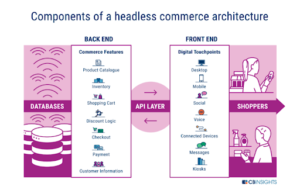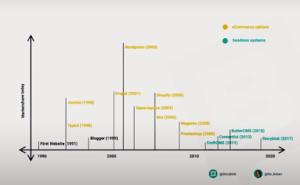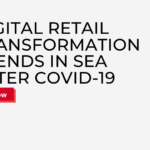As e-commerce adoption soars, the consumers’ shopping habits and expectations are constantly evolving. For retailers, the days of just showcasing the product details and SKUs on the online store are gone for good. The buzz right now is around the Customer experience featuring chatbots, loyalty & rewards, discounts, feedback & reviews, referral programs, 24/7 service, voice search, and much more. These set a strong precedent for e-retail businesses that are evolving through content-driven commerce. In the race to create a personalized and seamless customer experience, businesses are inclining towards headless commerce solutions.
In this article, we will discuss what is headless commerce, its impact on developing e-commerce solutions, and explore the benefits of choosing headless commerce.
1. Understanding the role of headless commerce
The list of user interfaces (UI) and customer touchpoints across multiple devices is no longer static, and the businesses must align all these touchpoints even when there are frequent updates. Maintaining a consistent experience across all these channels is important to create a personalized Customer Experience (CX) and adds to the overall Total Experience (TX) for a brand. But most existing e-commerce ecosystems comprise CMS systems that have tightly coupled UI and the backend database systems. Hence, making quick UI changes to all platforms to enhance CX becomes quite challenging and time-consuming.
Headless commerce, a term coined by Dirk Hoerig, co-founder of Commercetools, in 2013, is a promising solution for these challenges. It is an eCommerce solution with an architecture that separates the back-end from the front-end layer. This gives flexibility to brands to focus on the UI and personalize the presentation layer, giving an enriching experience to their shoppers.

2. Evolution of Headless commerce platforms
At first, e-commerce platforms were built for desktop purposes using a monolithic architectural approach. However, the mobile commerce boom over the past decade and a half, and the emergence of several other forms of e-commerce have given rise to multiple touchpoints to interact with its customers. It has become essential for businesses to keep customer interactions personalized, seamless, and consistent, across all touchpoints.
In a given e-commerce system, the head is the front-end (UI) and the body is the back-end (e-commerce engine), the customer touchpoint is the type of interface she interacts with, desktop, mobile app, website to name a few. To fulfill the complete omnichannel experience for shoppers, these ends must get decoupled. This enables retailers to embrace the freedom to incorporate frequent changes to the UI and create an unparalleled experience for the users. This need has pushed the retailers to adopt the flexible headless commerce approach that is helping companies to explore more engaging ways of serving customers. Headless commerce, to simply put, e-commerce experience with no strings attached!
Hence, if a business wants to conduct business across multiple e-commerce channels, it is imperative for them to shift towards headless commerce. It comes with a future-proof design that enables e-commerce to deliver innovative products as per the demand. This could even be a game-changer for many small retail brands to even compete with e-commerce giants, such as Amazon and Walmart, that are trying to capture their loyal customers.

3. How headless commerce works
Modern customers look for dynamic shopping capabilities on the online store, so front-end development teams need to have hands-on flexibility and not worry about modifying the database. At the same time, a robust backend system is equally important that can handle complex transactions, check-out, inventory, payment, subscriptions, compliance, and more.
The market intelligence firm, CB Insights depicts the components of headless eCommerce architecture is depicted as per below:

In this microservices-based architecture, there is no integration required between the front and back ends. These decoupled components communicate through the API layer. These RESTful APIs can run the show by pulling information from anywhere including mobile apps, desktops, social networks, kiosks, SMS, IoT, and wearable tech devices (Alexa, smart-watches & appliances, TV, etc). Thus, the gathered back-end information is pushed to the front-end for a true omnichannel experience.
Whenever the changes are made on the UI front, the APIs do all the work and there is no impact on the back-end, whatsoever. This also means that technology threats are isolated as well and will not affect the entire system.

4. Why e-commerce brands are going headless
Headless commerce is disrupting e-commerce and offering the technology for businesses to build and create future-proof seamless digital shopping experiences. Retailers must scale up to meet the demand of the increasing number of shopping experiences happening across several channels. To facilitate a unified omnichannel experience for users, brands are decoupling the storefront for the flexibility of swiftly creating frontend touchpoints.
Lisi Linhart at JSWorld Conference 2021 presented the changing shift of retailers towards headless CMS systems.

More and more businesses are moving away from traditional e-commerce and adapting to headless solutions for several reasons:
4.1. Flexibility for teams
By going headless, without disturbing the business infrastructure, brands can make ready updates on the customer-facing content layer. Marketers become the new developers launching promotions on the system without involving the developers.
Given the fact that most designers are not developers and vice versa, commerce platforms equip developers with tools and APIs for creating consistent UX across several platforms on a single viewpoint of data.
4.2. Customization
Given the decoupled headless architecture, the customizations on Layout, images, graphics, and branding can all be altered at speed. Teams can go selective with integrations that make sense to the business, rather than going on a bulk scale.
The back-end data helps brands to customize offers and more features as per buyer’s preferences, profile, and order history, and create memorable experiences, with back-end as it is.
4.3. Enhanced user experience
With a headless approach, creative teams can focus on enhancing the user experience. By powering up the front-end of the store, that the users see, and facilitating instant page-load times and smoother navigation, the site speed and performance can be boosted, eventually leading to higher revenue and conversion rates, besides enriched customer experience.
4.4. Faster Deployment
By employing headless commerce, retail businesses can launch new UI features very quickly and the new content updates instantly. Putting foot into the new trend can be done swiftly with minimal costs.
The headless system will cut down the time to launch, which is extremely beneficial for time-sensitive promotions, discounts, and offers for brands to start the market fast.
5. Conclusion
In today’s digital world, businesses need teams equipped with the ability to plan and respond quickly to the ever-changing shoppers’ needs. Headless commerce is a perfect solution to achieve the balance between a flexible front-end and a stable back end. It meets the millennial’s demand by crafting a consistent and personalized omnichannel experience.
Whilst traditional commerce can efficiently support a small online store with a single e-commerce website, as the business grows and the customers start to look for new platforms the problems start to show up. Hence, it is advised to find the right partner upfront to build your infrastructure that will support headless commerce is important, because it provides scope for easy incremental expansion as and when your business grows. If not, your initial investment used for creating a standalone website will go to waste.
The road to implementing a headless solution is full of choices. There are various options available in terms of the platforms and architecture. Hence, you must choose the right technology partner, not just who understands your business but also knows your customers, markets, and challenges.
Contact the experts at Kyanon Digital today for digital transformation solutions that best fit your brand, and emerge as a future-facing business model.


